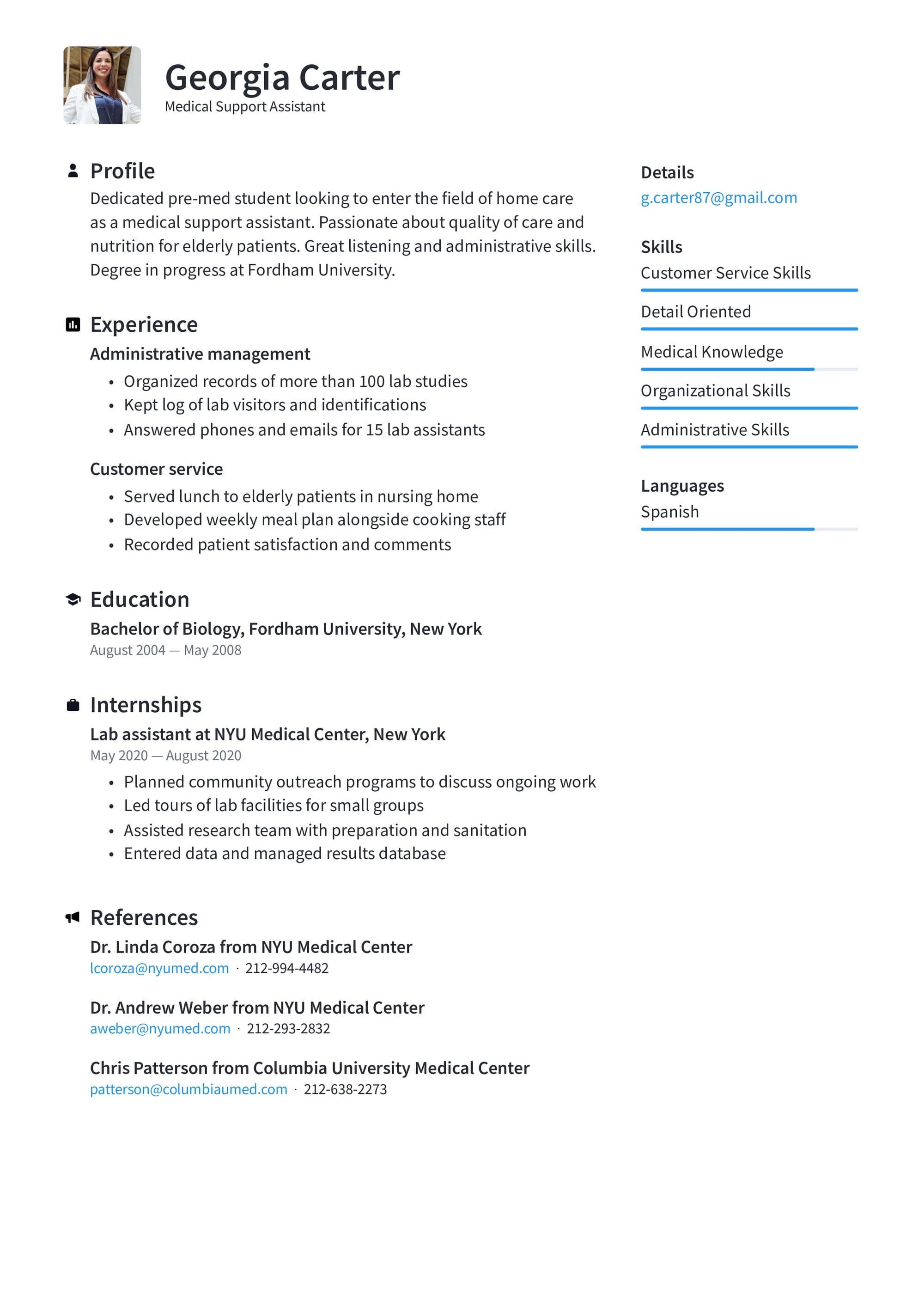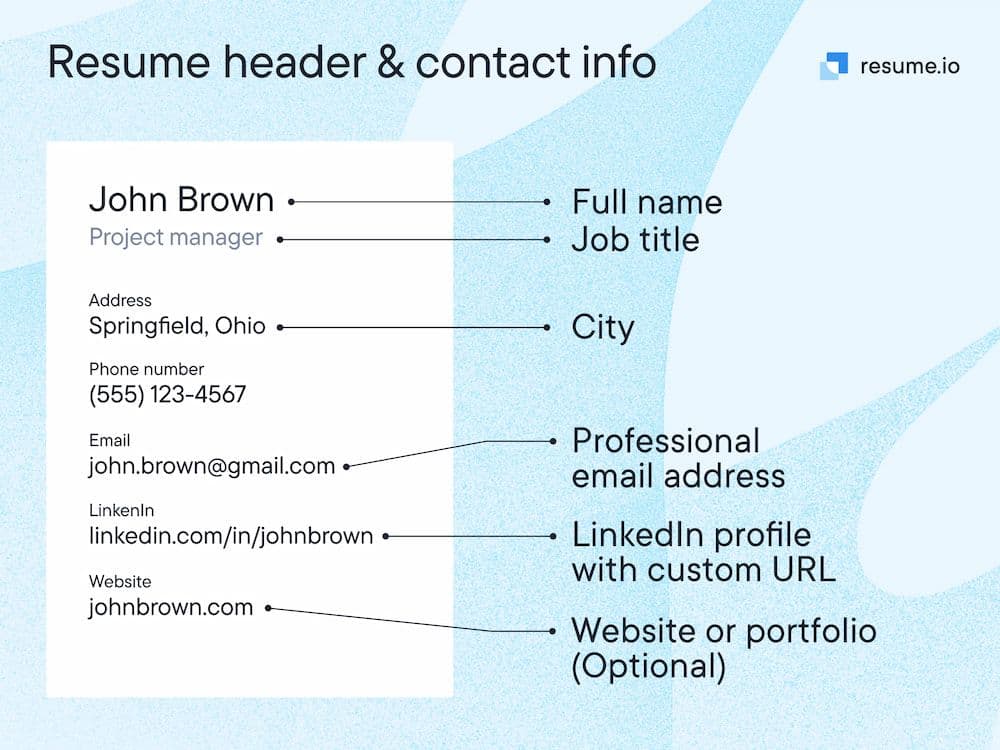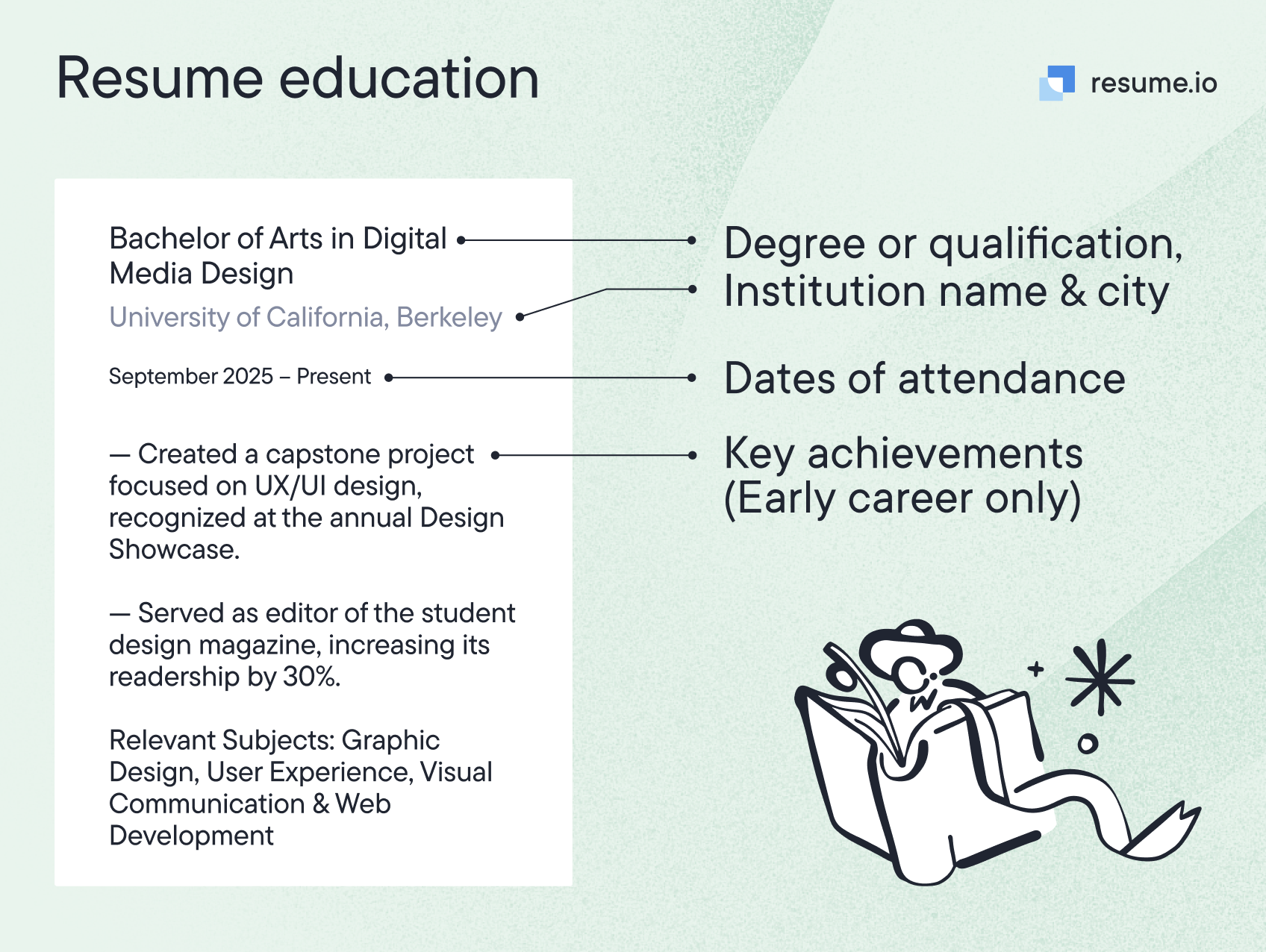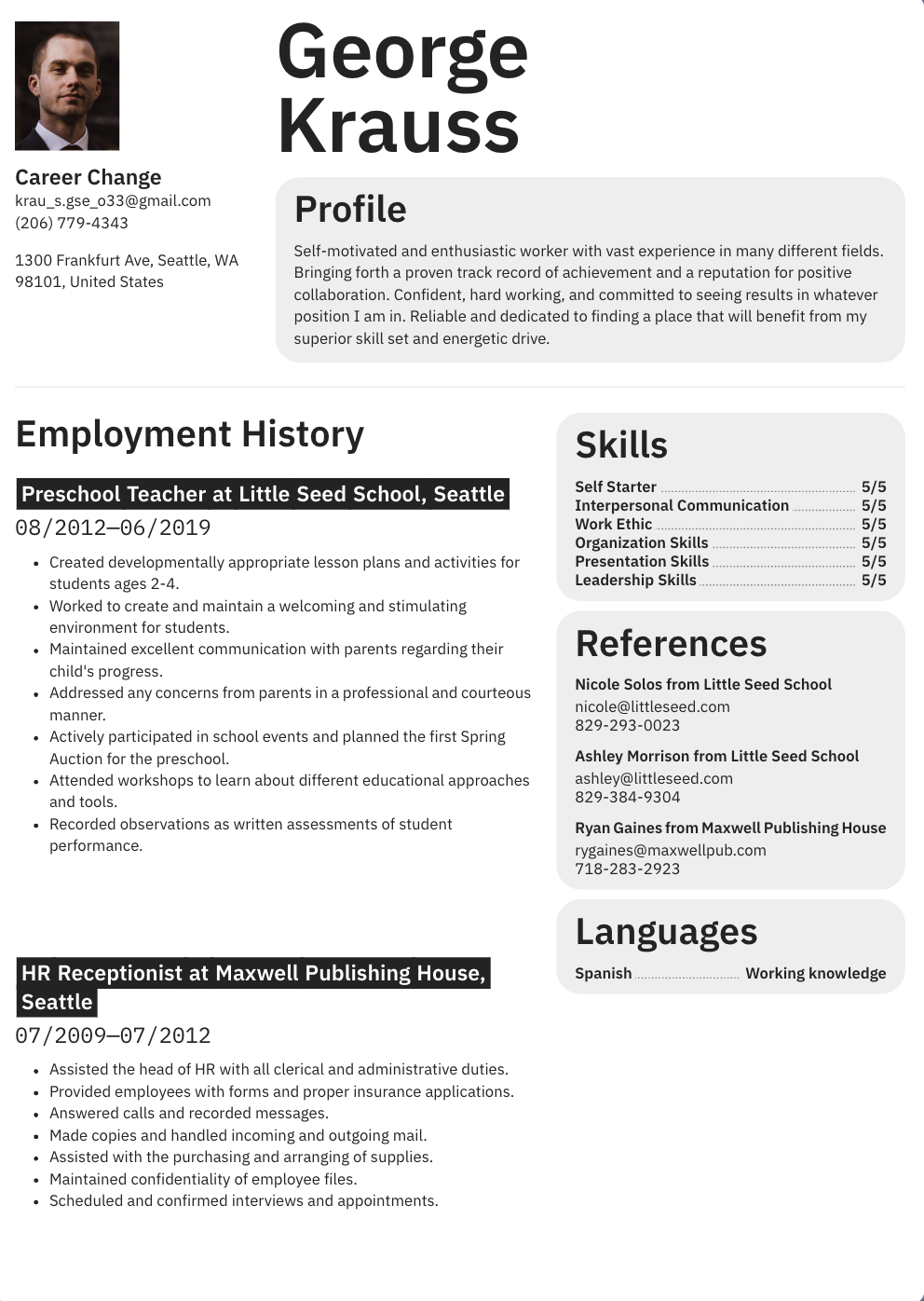Choosing your resume format is a very important decision, as you need to take into account your work history, skills, and education.
While the reverse-chronological format might be the “default,” a functional resume format, also known as a “ skills-based format,” can be a better choice, especially if you are a career changer, a recent graduate, or have gaps in your resume.
We’ll review what a functional resume format is, and how it can work for you, along with providing a variety of templates and examples from which you can choose.
What is a functional resume?
A functional resume, also known as a skills-based resume, highlights your skills and talents and how they relate to the job you’re applying for and places them at the top of your resume. Instead of listing your work history in reverse chronological order, it groups your skills and work history by category.
In this way, the functional resume takes the emphasis off of specific roles and places it directly on your transferable strengths. And, like other resume formats, you’ll want to tailor your functional resume for each job you apply for.

Here is an overview of the sections included in a functional resume format:
- Name and contact information
- Job title. This should match the job title you are applying for
- Resume objective/summary. Two to three sentences providing an overview of your skills, training, and accomplishments.
- Summary of applicable skills. Include any experience relevant to those listed in the job posting.
- Hard skills. This is the main focus of the resume, with the skills directly related to the job.
- Additional skills. Include soft skills that complement the job
- Education. Include any formal, vocational, and subsequent training in specific skills (this may precede the Skills section if you are a fresh grad or have received recent training that would qualify you for the position)
- Experience. A brief listing of employers, dates, and job title
- Industry related certifications
- Industry organizations
- Volunteer experience
When to use a functional resume?
A functional resume focuses on your skills and accomplishments, instead of your work history. This type of resume format is a good choice for the following types of job hunters:
- Those in technical or skill-based professions
- Career changers
- Recent graduates
- People with an “eclectic” work history.
- Applicants with a significant temporary or volunteer work history
- Those with gaps in their resume
Keep in mind, however, that an employer might have specific preferences when it comes to resume formats, so be sure to do your research to ensure that the hiring manager will be open to reading a functional resume format.
5 Steps to writing a functional resume
Writing a functional resume is a little different than the traditional reverse-chronological one, so it’s important to understand the sections required for this format, in what order they should be listed, and how to make your resume stand out.
1. Contact section
Your contact information, or “ header,” should be at the top of the page and will allow the employer to reach out to you to invite you to an interview.

You should include:
- First and last name
- Job title (optional)
- phone number
- city and state
- LinkedIn profile URL
Jane Smith
Marketing Assistant
jsmith@email.com
312.555.1212
Chicago, IL
linkedin.com/in/jsmith123
2. Resume objective/summary
After your contact information, the next item in your functional resume is a brief (2-3 sentence) summary of your professional background.
This summary or objective should grab the hiring manager’s attention and encourage them to continue reading your resume by summarizing your skills, experience, and ability to contribute to the employer’s business objectives.
(Adjective 1) and (adjective 2) (job title) who is passionate about (job duty) and offering (service provided by company) with efficiency and attention to detail. Excited to learn more about (field) from (company name) and be a part of achieving (goal.)

3. Skill section
In a functional resume format, the skills section is the most important and you will spend more time on this section than you would in other types of resumes.
The individual skills will be grouped in similar categories, described in more detail, and may also contain examples of accomplishments related to the skills. Use compelling action verbs and adjectives to describe your achievements, and incorporate keywords from the job description.
[First Hard or Soft Skill]
- Use bullet points to list accomplishments demonstrating this skill in action. Make sure you quantify (add numbers to) these bullet points
- Use quantifiable data when possible.
[Second Hard or Soft Skill]
- If you no longer use this skill in your current (or most recent) position, use the past tense to describe your accomplishments with this skill.
- Don’t be vague. Be specific when mentioning tech skills and the name of the app or software you used. Include your proficiency level, if applicable.
4. Education
List your schools in reverse order, starting with the most recent or highest degree attained. Make sure to include:
- Degree, with major and any minors if applicable
- School or institution
- Activities including offices held, organizations, key projects, or publications
If you have had informal education related to the jobs you’ve held or are applying to, the descriptions should include:
- Name of the class or certificate attained
- Instructional institution or issuing agency
- Dates

Leave off your date of graduation if it was more than 10 years ago. If any education, training, or certifications are listed as ‘Required’ in the job posting you are applying to, you may want to move this section to just below Skills and ahead of Experience.
- Degree name, university name, city, state
- Expected graduation mm/dd/yyyy degree, university name, city, state
5. Other sections
In a functional resume format, you will need to include other information that will be helpful for the hiring manager. They include:
- Volunteer work. Provide examples of skills you developed that are relevant to the position.
- Work history. Including your work history makes it more of a combination or “ hybrid” format, as it would emphasize both your work experience and skills equally.
- Languages. If you are fluent in languages other than English, make sure to include it.
- Projects. This section lists specific projects you've worked on, focusing primarily on the skills and abilities you used (or developed) and not the job title.
- Extracurricular activities. List hobbies, clubs, teams, or community service and the skills you developed. You can also include any awards or honors you’ve earned.
Job-specific functional resume examples & templates
Graduate/College Student
Student
Career changer

Other main resume formats

In addition to the functional format, there are two other main resume formats.
Chronological format
A chronological resume places the focus on your work history, starting with your most recent position, and working backwards. This format works well for someone with a clearly defined career path.
Combination (or “hybrid”) format
This format is just as its name implies: a combination of a chronological and functional format. While you start with your skills and qualifications, you also include your work history in reverse chronological order. The emphasis is placed equally on both sections.
Functional resume FAQs
Do employers like functional resumes?
While functional resumes will be suitable for certain job seekers, many hiring managers dislike them.
Functional resumes make it hard to understand when you’ve accomplished specific things; there is little opportunity to understand the context of accomplishments, and they automatically assume that the applicant is hiding something.
If you’ve been in the working world for more than three years, think very carefully about whether a functional resume format is best for you and avoid resume mistakes.
Pros and cons of a functional resume
A functional resume poses certain advantages when you don’t have a lot of relevant work experience. However, it's not the right choice for everyone since the structure can be limiting in terms of work history.
- Easy to create without much experience to go off of
- Allows you to highlight your personality traits
- A great option for students and recent grads
- Can be used to change careers and showcase transferable skills
- The best way to highlight education and abilities with no work experience
- No employment history section to highlight previous positions
- Can make you appear like an early-career candidate even if you're not
- Less ability to show hard skills or lessons learned on the job
- Not favored by employers for certain roles
- Stands out as a candidate who doesn't have experience in the field
When should you not use a functional resume?
There are a few instances when a functional resume format would not be your optimal choice:
- A hiring manager is looking for someone with practical experience in a position.
- You’re further along in your career and want to move up to the next logical position.
- You have a clearly defined career path and work history.
- You’re applying to a company that uses an Applicant Tracking System (ATS), as they’re harder for the software to read.
In these cases, a chronological resume format is your best bet.
Is a functional or chronological resume better?
It depends on your situation. If you’re a few years into your career and have a solid work history, use a chronological format. If you’re changing careers or a recent graduate without a lot of experience, a functional format will better highlight the skills and abilities you do have.
How to list skills on a functional resume
To list your skills on a functional resume, list a skill you want to highlight, then use bullet points underneath or at the side to describe how you’ve used these skills on the job, incorporating quantifiable data when possible.
What is the difference between a functional and a standard resume?
A functional resume emphasizes skills rather than work history. A standard (or chronological) resume focuses on career progression and achievements.
Can a functional resume be 2 pages long?
In general, you should stick to one page, but a two-page resume is okay if you have a wide range of experience, a lot of education, or a long list of diverse skills.
Need help formatting your resume? Resume.io’s Resume Builder has a variety of expert-tested resume templates designed to give you an edge and get hired faster.





